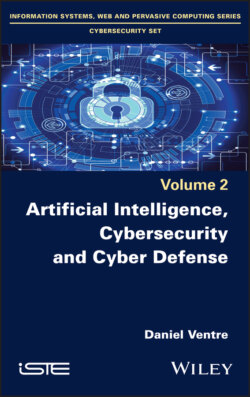Artificial Intelligence, Cybersecurity and Cyber Defence

Реклама. ООО «ЛитРес», ИНН: 7719571260.
Оглавление
Daniel Ventre. Artificial Intelligence, Cybersecurity and Cyber Defence
Table of Contents
List of Illustrations
List of Tables
Guide
Pages
Artificial Intelligence, Cybersecurity and Cyber Defense
Introduction
1. On the Origins of Artificial Intelligence. 1.1. The birth of artificial intelligence (AI) 1.1.1. The 1950s–1970s in the United States
1.1.2. AI research in China
1.1.3. AI research in Russia
1.1.4. AI research in Japan
1.1.5. AI research in France
1.2. Characteristics of AI research
1.3. The sequences of AI history
1.4. The robot and robotics
1.5. Example of AI integration: the case of the CIA in the 1980s
1.5.1. The CIA’s instruments and methods for understanding and appropriating AI adapted to its needs
1.5.2. Focus groups, research, coordination
1.5.3. The network of interlocutors outside the intelligence community
1.5.4. What AI applications for what intelligence needs?
2. Concepts and Discourses
2.1. Defining AI. 2.1.1. AI
2.1.2. Expert systems
2.1.3. Machine learning and deep learning
2.1.4. The robot, robotics
2.2. Types of AI
2.3. Evolution of the themes over time. 2.3.1. Google Trends
2.3.2. The AAAI magazine
2.4. The stories generated by artificial intelligence
2.4.1. The transformative power of AI
2.4.2. The absolute superiority of human intelligence over the machine
2.4.3. The replacement of humans by machines
2.4.4. AI as an existential threat
2.4.5. The place of AI and robotics in fiction: the example of Japan
2.5. Political considerations
2.5.1. National strategies for artificial intelligence
2.5.1.1. Russia’s strategy for 2019
2.5.2. U.S. policy. 2.5.2.1. Barack Obama’s presidency
2.5.2.2. The presidency of Donald Trump
3. Artificial Intelligence and Defense Issues
3.1. Military policies and doctrines for AI: the American approach. 3.1.1. American defense AI policy. 3.1.1.1. AI in speeches by the Secretary of the Department of Defense
3.1.1.2. DARPA’s strategic computing initiative (1983)
3.1.1.3. The MAVEN project and the creation of the AWCFT (2017)
3.1.1.4. Department of Defense strategy 2018
3.1.1.5. The American third offset strategy (TOS)
3.1.1.6. The quadrennial defense review (QDR)
3.1.2. AI in American military doctrines
3.1.2.1. U.S. Army and AI
3.1.2.2. U.S. navy and AI
3.1.2.2.1. The NCARAI
3.1.2.2.2. NCARAI publications
3.1.2.3. U.S. Marine Corps and AI
3.1.2.4. U.S. Air Force and AI
3.2. Military AI in Russia
Wars and armies are becoming more and more technologically advanced
AI and robotics will give rise to new weapons but probably not androids
AI can be applied to all military functions
AI paves the way for new operational modes
AI feeds the information space, constructs it and enriches it
It is essential to take into consideration the question of the relationship between humans and AI
Dependence on and effectiveness of intelligent systems does not preclude the issue of trust
Can AI be a weapon of dissuasion? What is the strategic role of AI?
The economic dimension is a key factor that legitimizes military AI research and the integration of AI into armies and warfare
3.3. AI and the art of warfare. 3.3.1. Manuel de Landa: war in the age of intelligent machines
3.3.2. AI announcing a new RMA?
3.3.3. Applications of AI in the military field
3.3.4. Expert systems in military affairs
3.3.5. Autonomous weapons
3.3.6. Robotics and AI
3.4. AI and cyber conflict
3.4.1. Malware, cybersecurity and AI
3.4.2. AI and cyberweapons
3.4.3. Offensive–defensive/security configurations
3.4.4. Adversarial AI and adversarial Machine Learning
3.4.5. AI and information warfare
3.4.5.1. AI and memetic warfare
3.4.6. Example 1: the war in Syria
3.4.7. Example 2: events in Hong Kong in 2019
3.4.8. Example 3: malicious AI attacks
3.4.9. Example 4: swarming attacks
3.4.10. Example 5: crossing universes with AI and without AI
Conclusion
Appendix 1. A Chronology of AI
Appendix 2. AI in Joint Publications (Department of Defense, United States)
Appendix 3. AI in the Guidelines and Instructions of the Department of Defense (United States)
Appendix 4. AI in U.S. Navy Instructions
Appendix 5. AI in U.S. Navy Instructions
Appendix 6. AI in U.S. Air Force Documents
References
Index. A, B, C
D, E, F
I, K, L
M, P, R
S, T, V, W
2020
2019
2018
2017
2016
2015
2014
2013
2012
2011
2010
2009
2008
2007
2006
2005
WILEY END USER LICENSE AGREEMENT
Отрывок из книги
Cybersecurity Set
.....
It was in these terms that Temple University invited managers from the business and administrative sectors to attend one of its conferences dedicated to AI in 1985. Today, AI still raises many questions, the same curiosity, and its transformative power is still highlighted, with the difference, however, that it is no longer a question of limiting the revolution to a few areas. It will affect all areas of human activity.
AI is already present, everywhere around us and in our daily lives, without us being aware of it most of the time. Modern vehicles that are equipped with electronics and computer technology are equipped with AI, where the software analyzes data from thousands of sensors in real time and performs calculations to regulate fuel supply and stabilize the vehicle, as well as many other functions. In autonomous vehicles, information systems take control: AI analyzes the data and “decides” the actions to be taken to drive the vehicle. Mobile phones, virtual assistants, social networks, anti-spam filters, video games, search engines, medical diagnostic support systems and simulation platforms are some of the applications that have benefited from AI, though it is impossible to draw up an exhaustive list. AI applications multiplied, in particular, during the 1980s, in the form of expert systems, of which industry, as well as defense forces, were major consumers.
.....